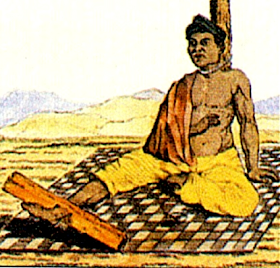A Singapore Slave Market, 1824

Munshi Abdullah bin Abdul Kadir's account of a slave market in Singapore in 1824, extracted from "Hikayat Abdullah"
One day during the season when the Bugis come to Singapore I saw fifty or sixty slaves male and female being led by a Bugis man round the town; among them were old and young, some carrying babies, some sick. They were herded along by a Bugis driver, holding in his hand a cane with which he struck at them here, there and everywhere. I went up to the man and said "Of what races are these people?" and he pointed them out to me saying "This is a Mangarai family. Here's a man from Mandar." He added "If you go out into the harbour there is a boat which arrived yesterday carrying three or four hundred slaves." Feigning interest I asked: "What price are these, and what price are those?". He replied: "These are forty dollars and those thirty dollars each." Then I continued on my way.
The next morning early I went out in the harbour to have a look. When I reached the boat, I found it full of slaves, about three hundred men, women and children. Some of the women were heavy with child, that is to say their hour had almost come, and seeing them my heart was moved with compassion. Hundreds of Chinese came to make purchases while I stood watching this pitiful sight, seeing pregnant women gazing at me with tear-stained eyes. It brought tears to my eyes also when I thought "Who are their husbands?" and when ì saw the cruel way in which these slaves were treated. They were being handed rice in coconut shells and water in bamboo scoops just as one gives food to dogs. When I went down inside I saw many women, some mere girls, some adolescent and other already grown up. Some were fair, other dark. They were all shades of colour. There were some who did not understand Malay, with frizzy hair and black faces. Only their teeth showed white. They had fat stomachs and thick lips.
The man who owned these slaves behaved like a beast, shameless and without fear of Allah. The younger girls hung round him while he behaved in a manner which it would be improper for me to describe in this book. For anyone who wished to buy these slave-girls he would open their clothing with all manner of gestures of which I am ashamed to write. The slave dealers behaved in the most savage manner, devoid of any spark of feeling, for I noticed that when the little children of the slaves cried they kicked them head over heels and struck their mothers with a cane, raising ugly weals on their bodies. To the young girls, who were in great demand, they gave a piece of cloth to wear, but they paid no attention to the aged and the sick.
The greatest iniquity of all that I noticed was the selling of a woman to one man and of her child to another. The mother wept and the child screamed and screamed when she saw her mother being taken away. My feelings were so outraged by this scene that, had I been someone in authority, I would most certainly have punished the wicked man responsible for it. Furthermore those in charge of male slaves tied them round the waist like monkeys, one to each rope, made fast to the side of the boat. They relieved nature where they stood and the smell on the boat made one hold one's nose. The majority of the female slaves were Balinese and Bugis. They were bought up by men of all races, Chinese, Indians, Malays, who took them to wife and whose numerous progeny are here to the present day. There were also Malay boats bringing slaves from Siak. A great number of them came from the hinter-land of Siak, from Menangkabau and from Pekan Baharu. They were all being herded into Singapore, driven along the road and beaten with canes like goats being taken to market.
That is how slaves were sold in those days both in Malacca and in Singapore, like a cattle market. I went back to the town and told Mr. Raffles all about what I had seen. He replied 'That business will not last much longer for the English are going to put a stop to it. It is a wicked thing and many people have gone and made reports about it to Parliament in England demanding that the slave trade shall cease", and he added "It is not only here that this sinful business goes on. To England too boatloads are brought from other countries, and thousands of the black men are turned into slaves. Then they are put up like goods for sale in all the countries of Europe. If we live to be old we may yet see all the slaves gain their freedom and become like ourselves.
* * *
Slavery in Singapore existed up for another 20 years after this. The 1833 Slavery Abolition Act of the Parliament of the United Kingdom abolished slavery throughout the British Empire, with the exceptions "of the Territories in the Possession of the East India Company," the "Island of Ceylon," and "the Island of Saint Helena"; the exceptions were eliminated in 1843. With the exception of the Straits Settlements, slavery continued to exist on the Malay Peninsula until the establishment of the Federated Malay States in the mid-1870s.
Dapatkan lebih banyak info terkini di Channel Rasmi Cari Dot My
|




